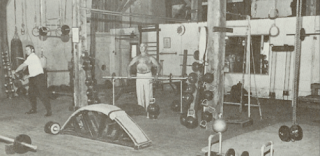 |
| This is a real T-shirt...and get it here! |
So it only makes sense when I see someone picking up something way too heavy, with their body simultaneously convulsing like they're being electrocuted and bending like an overloaded beer trailer at a Cinco De Mayo party, I'm not really that impressed. In fact, just downright hideous. Lifting like that isn't impressive and I'll tell you why. There's such a thing known as absolute strength and that's using 100% of your muscles. At any given time, you barely use a third of your power, even if you think you're using it all. Your mind blocks most of the power subconsciously because it's for emergency use only. Your tendons and ligaments probably won't hold up to that kind of contractile force. If your mind senses a life or death situation, then it'll kick in. After all, what good are in tact connective tissue on a corpse?
So, I've established that I'm no fan of lifting grotesquely past physical limitations. I'm also not always a of a fan of modifying equipment to make lifting easier simply for the sake of moving more weight. What I'm getting with this statement is some of the sandbag lifts I've seen. Since I bought my Alpha Strong Sandbags two years ago, a day rarely goes by when I don't use either Thy Beast or, more recently, Thy Kraken. Implicit in sandbag training is that the sand can shift with each lift, creating an awkward weight that isn't exactly the same each time you pick it up and put it down. That movement is the cornerstone of sandbag training. So, it baffles my mind to see people filling sandbags to the point where they are rigid and, even worse, finding a way to tie them up so the sand barely shifts at all.
...I had a specific video in mind of an an Xpurt doing exactly this but it won't upload! Shit!
I learned quickly that I had to learn how to do a clean if I wanted to get serious about training with sandbags. I'd never done a barbell clean previously. When I got around to doing one, with 135 lbs, I was surprised that it was much easier than cleaning my 87 lbs sandbag. That's how much difference a shifting weight can make. Sandbags aren't simply about how much they weigh. It's about how much more they fight back when we attempt to lift them.
In case you're wondering if I still do BW and if I still write about it yet then the answer is still yes to both and I've got some major peeves about what passes as rope climbing in some circles. Unless you're Czech, there probably isn't any organized rope climbing competitions unless it's part of an obstacle course. If there was one that I started, the goal would be to get up it as fast as possible, not counting the descent speed for anything. The reason should be self-explanatory: too easy to let gravity do the work for you. That should count as much for rope climbing as a six-pack counts on a skinny guy.
Maybe that's why I have a certain aversion to what competitive lifters of all stripes do for training. The way I see it, it's all ass-backwards. They all do different lifts but they all have the same thing in common: they want to lift as much weight as possible with a few, chosen moves. They define strength too narrowly. When goals around movement become too focused, the mind looks for shortcuts. These shortcuts always have a way of loosing the purpose of the exercise in the first place. Perhaps this is more apparent to me as I watch my left thigh atrophy from weeks of being nothing more than a few dozen pounds of deadweight and my frustrated mind aches for physical stimulation beyond hobbling around on crutches.
Yes, I'm currently reduced to being an internet couch judge. If you're not, then for fucks sake don't take for granted that you can move, lift and climb. Don't waste that ability on short-cuts.
Or maybe I'm an asshole like the rest of them...



